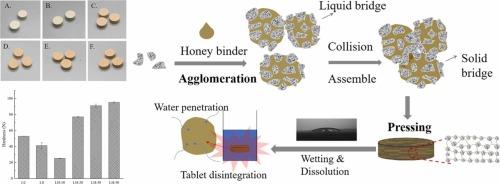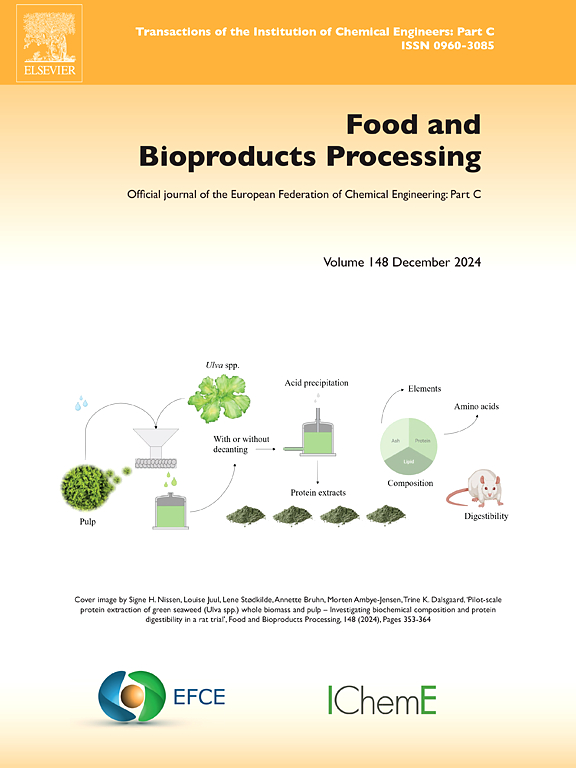Effect of honey from fluid bed agglomeration to tableting of plant-based food powder: A case study of lotus seed powder
IF 3.4
2区 农林科学
Q2 BIOTECHNOLOGY & APPLIED MICROBIOLOGY
引用次数: 0
Abstract
Plant-based food material is developed into tablet based on the consideration that food is medicine. However, the inhomogeneity of plant powders without fractionation and with less additive added aiming for clean label production, both lead to the difficulties on constructing a stable tablet structure. Therefore, lotus seed powder was used as model plant powders, while honey was used in fluidized bed agglomeration to investigate the handling and compressibility of powder. The results showed that increased honey binder (10 %-50 %) resulted in increased particle size accompanied with more irregular particulate shape. With 50 % honey, the largest D50 of agglomerate was obtained with 205.18 ± 9.54 μm in comparison with control sample at 23.28 ± 1.28 μm. In addition, the wettability of lotus seed powder was enhanced where the agglomerated powders were wetted less than 4.56 ± 1.19° within one min. However, the solubility of agglomerate lotus seed powder remained poor due to less influence by fluid bed drying. The agglomerated powder showed lower bulk density and tapping density with better flowability where the Carr index was between 17.964 % and 20.075 %. The improved followability is beneficial to form homogeneous powder matrix. Moreover, the modified powder matrix enabled the agglomerated lotus seed powder (over 20 % honey) more compressibility and higher hardness. The highest hardness (95.32 ± 0.84 N) of powders was observed by 50 % honey agglomeration which was significantly greater than 25.17 ± 0.29 N in raw powder. Moreover, the tablet disintegration time was shortest when 50 % honey agglomeration was added.

蜂蜜流化床团聚对植物性食品粉片化的影响——以莲子粉为例
植物性食品材料是基于食物即药物的考虑而发展成片剂的。然而,不分选的植物粉末的不均匀性和以清洁标签生产为目标的添加剂添加较少,都导致了构建稳定片剂结构的困难。因此,以莲子粉为模型植物粉,以蜂蜜为流化床团聚体,研究粉末的处理和可压缩性。结果表明:蜂蜜黏合剂浓度增加(10 % ~ 50 %),颗粒尺寸增大,颗粒形状不规则;当蜂蜜含量为 % 50时,团聚体的D50为205.18 ± 9.54 μm,而对照组的D50为23.28 ± 1.28 μm。此外,莲子粉的润湿性在1 min内湿润度小于4.56 ± 1.19°时得到增强,但由于流化床干燥对莲子粉的影响较小,莲子粉的溶解度较差。结块后的粉体容重和出丝密度较低,流动性较好,Carr指数在17.964 % ~ 20.075 %之间。随性的提高有利于形成均匀的粉末基体。此外,改性后的莲子粉(蜂蜜含量≥20% %)可压缩性更强,硬度更高。当蜂蜜结块率为50% %时,粉末硬度最高(95.32 ± 0.84 N),显著高于原料粉的25.17 ± 0.29 N。当蜂蜜团聚量为50% %时,片剂崩解时间最短。
本文章由计算机程序翻译,如有差异,请以英文原文为准。
求助全文
约1分钟内获得全文
求助全文
来源期刊

Food and Bioproducts Processing
工程技术-工程:化工
CiteScore
9.70
自引率
4.30%
发文量
115
审稿时长
24 days
期刊介绍:
Official Journal of the European Federation of Chemical Engineering:
Part C
FBP aims to be the principal international journal for publication of high quality, original papers in the branches of engineering and science dedicated to the safe processing of biological products. It is the only journal to exploit the synergy between biotechnology, bioprocessing and food engineering.
Papers showing how research results can be used in engineering design, and accounts of experimental or theoretical research work bringing new perspectives to established principles, highlighting unsolved problems or indicating directions for future research, are particularly welcome. Contributions that deal with new developments in equipment or processes and that can be given quantitative expression are encouraged. The journal is especially interested in papers that extend the boundaries of food and bioproducts processing.
The journal has a strong emphasis on the interface between engineering and food or bioproducts. Papers that are not likely to be published are those:
• Primarily concerned with food formulation
• That use experimental design techniques to obtain response surfaces but gain little insight from them
• That are empirical and ignore established mechanistic models, e.g., empirical drying curves
• That are primarily concerned about sensory evaluation and colour
• Concern the extraction, encapsulation and/or antioxidant activity of a specific biological material without providing insight that could be applied to a similar but different material,
• Containing only chemical analyses of biological materials.
 求助内容:
求助内容: 应助结果提醒方式:
应助结果提醒方式:


